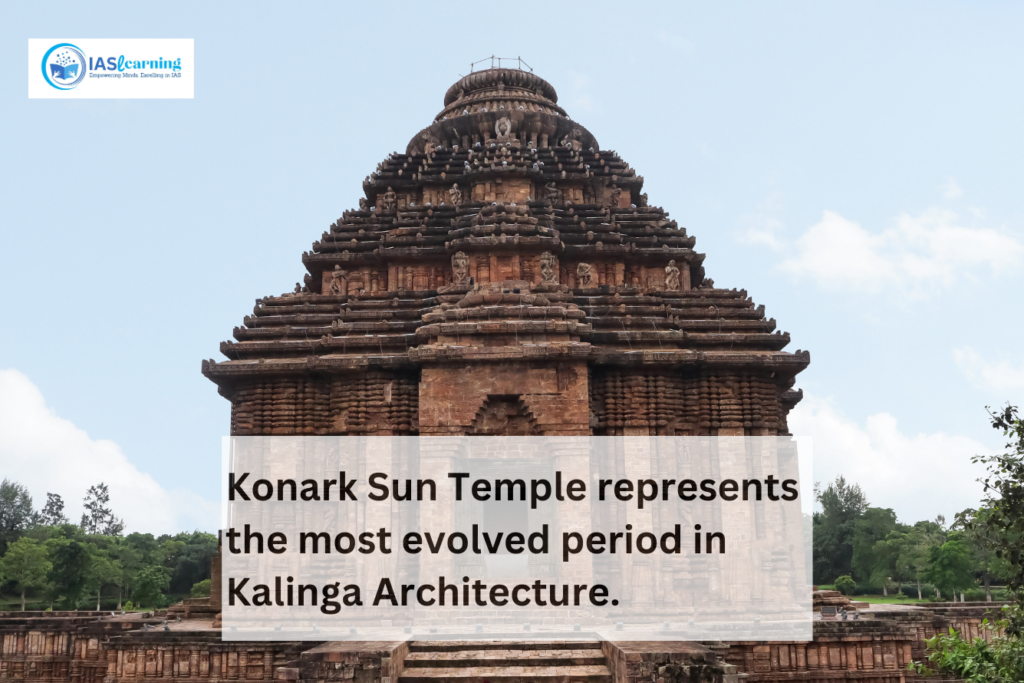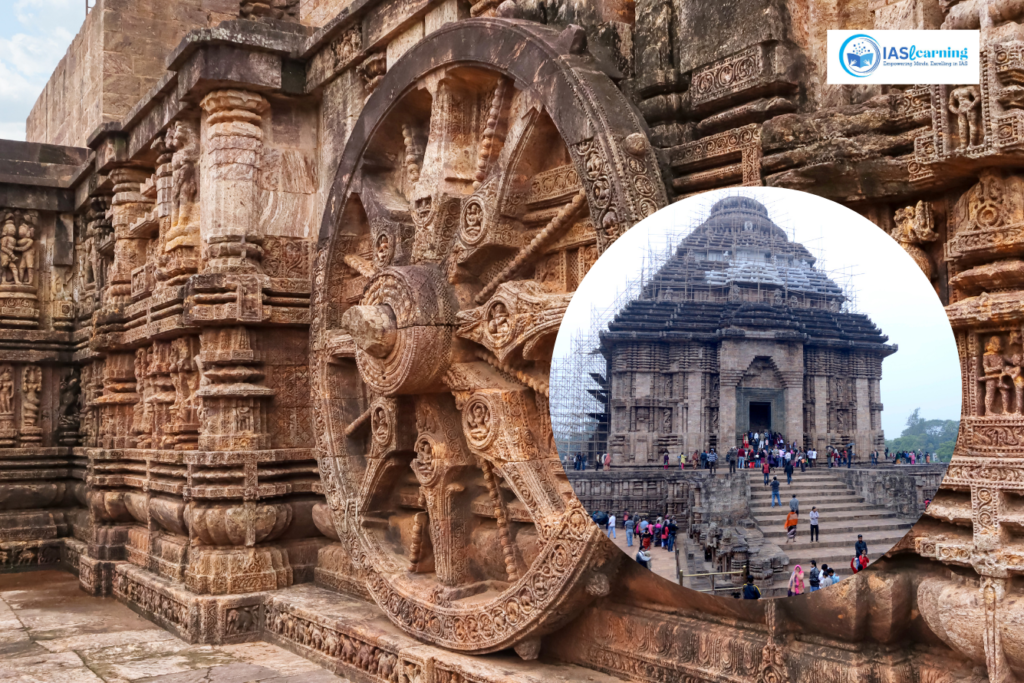What is the story of Sun Temple of Konark?
Context: The mural of the iconic Konark Sun Temple wheel was showcased to the World Leaders at the G20 Summit.
Konark Sun Temple
The mural of the iconic Konark Sun Temple wheel was showcased to world leaders at the G20 Summit, which is why it was in the news. The Konark Sun Temple is a UNESCO World Heritage Site and is renowned for its architectural and artistic significance. Here is some additional information about the temple:
Konark Sun Temple:
- Also Known As: The temple is known by several names, including the Black Pagoda, Arka Kshetra, and Padma Kshetra.
- Construction: The Sun Temple and the famous Konark Wheel were built during the 13th century under the reign of Eastern Ganga King Narasimhadeva-I.
- Significance: Sun temples are dedicated to the worship of the Sun God and are designed to highlight the celestial movement of the Sun. The Konark Sun Temple is a remarkable example of temple architecture and artistry.
- Materials: The temple was constructed using various types of rocks, including chlorite, laterite, and khondalite rocks, which are known for their durability and suitability for intricate carving.
- Description: The Konark Sun Temple is celebrated for its intricate and detailed carvings, which depict various aspects of life, mythology, and celestial themes.
- Rabindranath Tagore’s Praise: Nobel Laureate Rabindranath Tagore once described the Konark Sun Temple as the place where the “language of stone surpasses the language of man,” highlighting the temple’s architectural and artistic brilliance.

The showcase of the Konark Sun Temple’s iconic wheel to world leaders at the G20 Summit likely aimed to promote India’s rich cultural heritage and architectural excellence on the global stage. It serves as a reminder of the significance of this historic and artistic treasure.
| Eastern Ganga Dynasty |
| The Eastern Ganga Dynasty, also known as the Chodaganga Dynasty, was a prominent ruling dynasty in the region of Kalinga, which corresponds to modern-day Odisha, India. Here are some key points about the Eastern Ganga Dynasty: Historical Timeline: The Eastern Ganga Dynasty ruled over Kalinga from the 5th century to the early 15th century. They held power in the region for a significant period. Western Ganga Connection: According to early Chodaganga copper-plate grants, the Eastern Gangas of Kalinga were considered a branch of the Western Ganga family, a ruling dynasty in Mysore. This suggests a historical connection between the two dynasties. Founding and Early Rulers: While Kamarnava is believed to be the founder of the Eastern Ganga dynasty, it is Indravarman I who is the first historical ruler known from reliable records. His Jirjingi copperplate grant was issued in 537 CE. This indicates the establishment of a formal historical record for the dynasty. Prominent Ruler: One of the most powerful rulers of the Eastern Ganga Dynasty was Anantavarman Chodaganga. His reign marked a significant period of prosperity and expansion for the dynasty. |
The structure of the Konark Sun Temple
1. Main Entrance (Gajasimha): The main entrance to the Sun Temple is known as Gajasimha, where “gaja” refers to elephants, and “simha” means lions. In mythology, both elephants and lions symbolize different aspects of life, such as pride and wealth, and they are both capable of causing harm to humans.
2. Natya Mandapa: The Gajasimha entrance leads to the Natya Mandapa, a finely carved hall designed for dance and theatrical performances. The sculptures adorning this area depict various dance styles and forms.
3. Jagamohan or Mukhasala: Following the Natya Mandapa, there is the Jagamohan, which serves as the assembly hall of the temple. The steps leading to the Jagamohan are flanked by stone horses, adding to the temple’s artistic and cultural significance.
4. Deul (Sanctum Sanctorum): The Jagamohan is followed by the Deul, which is the sanctum sanctorum of the temple. This is the central and most sacred part of the temple where the deity is enshrined. The Deul is a crucial element in any Hindu temple.
5. Bhoga-mandira (Kitchen): The temple complex also includes a Bhoga-mandira, which serves as a kitchen where offerings (bhoga) are prepared for the deity and for devotees. This area plays an important role in the temple’s rituals and worship.

Kalinga architecture
| Kalinga architecture is a distinct architectural style that developed in the historic region of Kalinga, which corresponds to modern-day Odisha, India. This architectural style is characterized by a fusion of elements from both Northern and Southern Indian temple architecture traditions. Here are some key features and categories of Kalinga architecture: Combination of Styles: Kalinga architecture combines elements from the Nagara style of Northern India and the Dravida style of South India. This fusion creates a unique and distinctive architectural tradition. Typical Structure: A typical Kalinga temple consists of two main components: Sanctum (Deul): The sanctum is the core of the temple and houses the main deity’s idol. It is the innermost and most sacred part of the temple. Hall (Jagamohana): The hall serves as an assembly or congregation area for devotees. It is the space where rituals, prayers, and ceremonies take place. In early-period temples, the Jagamohana might be absent. Additional Components: Over time, Kalinga architecture evolved to include additional components in temple construction: Natya Mandapa: This is a hall for dance and theatrical performances. It is often elaborately carved and serves as a place for cultural and artistic activities. Bhoga Mandira: The Bhoga Mandira functions as a kitchen or preparation area for offerings (bhoga) made to the deity and for distribution to devotees. Categories of Kalinga Architecture: Kalinga architecture can be broadly classified into three main categories based on the shape and structure of the temple tower (shikhara): Rekha Deul: These temples have a square plan and feature a curvilinear tower that resembles a shikhara. The shikhara is a prominent and characteristic feature of North Indian temple architecture. Pidha Deul or Bhadra Deul: Temples of this type have a square plan with a pyramidal tower composed of horizontal tiers arranged in a receding manner. This style is influenced by South Indian Dravida architecture. Khakhara Deul: These temples have a rectangular plan with a barrel-shaped (vault shape) tower. This style is distinctive and unique to Kalinga architecture. |
The Konark Sun Temple, with its remarkable architectural and artistic features, is a significant cultural and historical monument in India. Here are some of the key architectural features of the temple:
Sun Rays: The Sun Temple at Konark was ingeniously designed so that the first rays of the rising sun would illuminate the sanctum and the presiding deity. This solar alignment is a testament to the temple’s devotion to the Sun God, Surya.
Chariot Design: The temple is designed to resemble a chariot of Surya, the Sun God. This design is characterized by the following elements:
- The temple stands on a base with a total of 24 intricately carved wheels, with 12 on each side.
- The chariot appears to be drawn eastwards, symbolizing the Sun’s journey towards the dawn, by a team of seven spirited horses.
Konark Wheel: The thicker wheels of the chariot are all carved with circular medallions at their centers on the widest part of the face. The rims of the wheels are adorned with designs of foliage, birds, and animals, while the medallions in the spokes feature figures of women in various poses, often of a sensual nature.
Seven Horses: The seven horses that pull the chariot are named in the Bhagavad Gita and are associated with rhythmic representation of sacred verses from the Vedas. They are also named after the seven colors of the rainbow.
Carvings of the Temple: The temple is adorned with intricate carvings that depict various aspects of life, mythology, and culture, including the following:

- War Horses: Two carved war horses in front of the temple represent strength and energy.
- Sun God: The temple features three impressive carvings of the Sun God at strategic locations to capture the sun at dawn, noon, and sunset.
- Everyday Activities: Carvings on the base and walls of the temple portray everyday activities.
- Mythical Creatures: Some carvings depict mythical creatures, animals like elephants and birds, and sensuous details.
Different Interpretations of the Konark Wheel:
- Time: The wheels of the chariot have been associated with the concept of time, representing days, months, hours, and prahars (three-hour periods).
- Life Cycle: Some interpret the wheels as a representation of the cycle of creation, preservation, and realization.
- Zodiac Signs: The 12 pairs of wheels may symbolize the 12 zodiac signs.
- Dharmachakra: The wheel has also been likened to the Dharmachakra, the Wheel of Karma and the Law, associated with Buddhism.
- Sun Dial: The wheels can function as sundials to tell time.
- Symbol of Democracy: The wheel has been seen as a symbol of democracy, reflecting democratic ideals and societal progress.
The Sun Temple at Konark is a masterpiece of Kalinga architecture and a symbol of India’s rich cultural heritage. It continues to captivate visitors with its architectural grandeur, artistic beauty, and its profound connection to the celestial movements of the sun.




